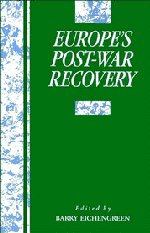Book contents
- Frontmatter
- Contents
- List of contributors
- Preface
- Part I Introduction and survey
- Part II The Marshall Plan
- 2 The Marshall Plan reconsidered
- 3 Influencing aid recipients: Marshall Plan lessons for contemporary aid donors
- Part III Other international initiatives
- Part IV Country studies
- Part V Synthesis
- Index
2 - The Marshall Plan reconsidered
Published online by Cambridge University Press: 07 September 2010
- Frontmatter
- Contents
- List of contributors
- Preface
- Part I Introduction and survey
- Part II The Marshall Plan
- 2 The Marshall Plan reconsidered
- 3 Influencing aid recipients: Marshall Plan lessons for contemporary aid donors
- Part III Other international initiatives
- Part IV Country studies
- Part V Synthesis
- Index
Summary
Introduction
Since the collapse of central planning in the former Soviet bloc, the need for Western aid for the transforming economies of the East has been hotly debated. The case for assistance has been argued since the outset of Eastern Europe's transformation; Jacques Delors, President of the European Commission, advanced one of the first proposals in 1989. Five years after the fall of the Berlin Wall, debate continues to rage. Although some aid has been extended in the form of individual loans and technical assistance, the kind of coordinated package for which the advocates of aid call has yet to be agreed upon.
The obvious precedent for such a package is the Marshall Plan, the program of assistance extended by the United States to Western Europe after World War II. Between 1948 to 1951, $12.4 billion of Marshall aid was provided, the equivalent of $65 billion in 1989 prices. The analogy has not been lost on today's observers: the relevance of the Marshall Plan to the current debate has been considered by Kirman and Reichlin (1991), Eichengreen and Uzan (1992), and DeLong and Eichengreen (1993), among others.
This chapter extends that analysis. Its aim is to provide an explicit comparison of economic and political circumstances in post-World War II Western Europe and post-Cold War Eastern Europe to help weigh the case for a new Marshall Plan.
Several issues spring from the comparison. One is the relationship between growth and stabilization. Different Western European countries stabilized in different ways: some early, others late, some abruptly, others gradually. Yet in all of these countries, growth resumed quickly and proceeded vigorously.
- Type
- Chapter
- Information
- Europe's Postwar Recovery , pp. 39 - 67Publisher: Cambridge University PressPrint publication year: 1995
- 2
- Cited by

